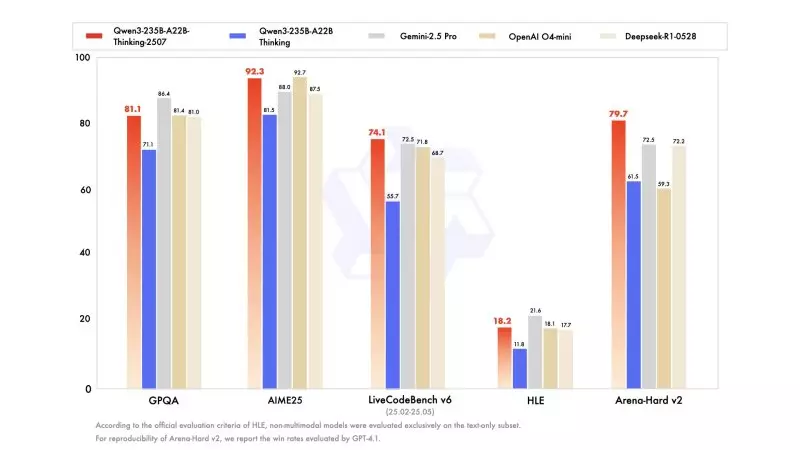In a landscape historically dominated by corporate giants with tight control over their AI models, Alibaba’s Qwen Team emerges as a formidable disruptor. Their recent torrent of releases—four robust models in just a week—signals an unambiguous shift toward democratizing artificial intelligence. Rather than flooding the market with merely incremental upgrades, Alibaba’s approach is strategic and ambitious: pushing the boundaries of performance, transparency, and accessibility. This effort challenges the status quo where access to cutting-edge AI often comes with restrictive licenses, costly API usage, or opaque development practices. The open-source movement, energized by Alibaba’s contributions, places control back into the hands of developers, researchers, and enterprises seeking flexible, ethical, and cost-effective solutions.
This strategic pivot signifies more than technical prowess; it highlights a philosophical stance. Alibaba seems to recognize that the future of AI does not solely lie in proprietary dominance but resides in a resilient, community-driven ecosystem. The company’s decision to release models under the Apache 2.0 license is a testament to their commitment to open innovation—an act that will likely accelerate progress across multiple industries and include a broader set of contributors. In an era where AI is increasingly integral to business and societal functions, such a move acts as a vital statement: AI should serve collective advancement, not just corporate profit.
Technical Breakthroughs as Catalysts for Broader Impact
The core strength of Alibaba’s latest models lies in their comprehensive performance across an array of benchmarks—some of the most challenging in the AI field. Notably, the Qwen3-Thinking-2507, with its specialized reasoning capabilities, surpasses many leading models. Its advanced chains-of-thought reasoning and self-reflective processes enable it to accomplish complex problem-solving tasks that previously required either proprietary, high-cost solutions or extensive custom engineering. This model’s achievements on benchmarks like AIME25 and LiveCodeBench v6 demonstrate that open-source models can now compete, and even excel, against industry giants like OpenAI, Google, and Anthropic.
What makes this breakthrough even more compelling is Alibaba’s clear focus on modularity. Their decision to differentiate models designated for reasoning from those optimized for instruction exemplifies thoughtful, long-term planning. Instead of building monolithic, hybrid systems, Alibaba’s segmentation allows tailored fine-tuning, better performance, and easier deployment—features especially attractive to enterprises that require robustness and flexibility. By equipping these models with long-context capabilities (supporting up to 1 million tokens in certain models), Alibaba caters to complex applications requiring deep contextual understanding—such as legal analysis, scientific research, or multi-turn dialogues—broadening the scope of practical AI use cases.
Empowering the Ecosystem: From Developers to Enterprises
Alibaba’s strategic move extends beyond mere technical superiority; it emphasizes ecosystem building. The availability of models on platforms like Hugging Face and ModelScope ensures seamless integration and widespread accessibility. The permissive Apache 2.0 license facilitates not only experimentation but also production deployment without the typical legal or financial restrictions that hinder innovation. This represents a significant shift, as many contemporary models restrict commercial use or impose tight API boundaries, limiting the scalability and customization needed by global organizations.
Furthermore, the models’ compatibility with popular frameworks and deployment environments—such as local inference, API integrations, or vendor-specific cloud services—democratizes AI adoption. Small startups, large corporations, and research institutions alike can now leverage Alibaba’s sophisticated models without considerable investment or vendor lock-in. This fosters a competitive environment where innovation is driven by capability and creativity rather than proprietary exclusivity. The long-term implication? A vibrant ecosystem where open, high-performance AI models serve as foundational building blocks for sectors like finance, healthcare, logistics, and beyond.
Implications for the Future of AI Development
Alibaba’s recent innovations signal an inflection point in the AI industry—paving a route where openness and performance are no longer mutually exclusive. As models like Qwen3-Thinking-2507 demonstrate, the future belongs to those who prioritize transparency, adaptability, and community collaboration. The model’s impressive results challenge entrenched perceptions that only massive, proprietary systems can achieve groundbreaking benchmarks.
This signals a paradigm shift where open-source models may eventually fill the gaps left by proprietary counterparts—offering not just comparable performance, but enhanced control and ethical oversight. Enterprises will find themselves increasingly empowered to self-host, customize, and deploy AI solutions aligned with their specific needs—shaping an environment where innovation accelerates and democratizes faster than ever before. In the end, Alibaba’s bold move isn’t merely about competitive advantage; it’s about reimagining the very foundation of AI development in a way that fosters collective intelligence and shared progress.

